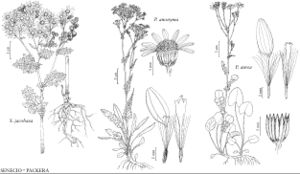Difference between revisions of "Packera aurea"
Bot. Not. 128: 520. 1976.
FNA>Volume Importer |
FNA>Volume Importer |
||
| Line 77: | Line 77: | ||
|publication year=1976 | |publication year=1976 | ||
|special status= | |special status= | ||
| − | |source xml=https://jpend@bitbucket.org/aafc-mbb/fna-data-curation.git/src/ | + | |source xml=https://jpend@bitbucket.org/aafc-mbb/fna-data-curation.git/src/f50eec43f223ca0e34566be0b046453a0960e173/coarse_grained_fna_xml/V19-20-21/V20_1285.xml |
|tribe=Asteraceae tribe Senecioneae | |tribe=Asteraceae tribe Senecioneae | ||
|genus=Packera | |genus=Packera | ||
Revision as of 20:24, 16 December 2019
Perennials, 30–60+ cm; rhizomatous and/or fibrous-rooted (rhizomes or caudices erect to horizontal). Stems 1 or 2–3+, clustered, glabrous or leaf axils tomentose. Basal leaves petiolate; blades cordate to reniform, 20–60 × 20–60 mm, bases abruptly contracted or ± cordate, margins crenate to crenate-serrate (apices rounded, faces glabrous). Cauline leaves gradually reduced (petiolate or sessile, not clasping; blades oblong to lyrate, lateral lobes 2–4 pairs). Heads 6–20+ in corymbiform to subumbelliform arrays. Peduncles bracteate, glabrous or sparsely tomentose. Calyculi inconspicuous. Phyllaries 13–21, green (tips purple or black), 6–8 mm, glabrous or sparsely tomentose proximally. Ray florets (8–)10–13; corolla laminae 8–10+ mm. Disc florets 55–70+; corolla tubes 3–3.5 mm, limbs 2–2.5 mm. Cypselae 1–1.5 mm, glabrous; pappi 4.5–5.5 mm. 2n = 44.
Phenology: Flowering late Feb–early May (south), late May–early Aug (north).
Habitat: Damp and swampy places in woodlands, meadows, along gravel banks and streambeds, acidic or sandy/gravelly soils
Elevation: 0–1500 m
Distribution

St. Pierre and Miquelon, Man., N.B., Nfld. and Labr., N.S., Ont., P.E.I., Que., Ala., Ark., Conn., D.C., Fla., Ga., Ill., Ind., Iowa, Ky., Maine, Md., Mass., Mich., Minn., Miss., Mo., N.H., N.J., N.Y., N.C., N.Dak., Ohio, Okla., Pa., R.I., S.C., S.Dak., Tenn., Vt., Va., W.Va., Wis.
Discussion
Packera aurea is abundant and widespread throughout eastern United States and Canada. It reproduces asexually from branched rhizomes or from adventitious shoots. Putative hybrids between P. aurea and P. paupercula, P. pseudaurea, P. schweinitziana, and P. tomentosa have been reported.
Selected References
None.
